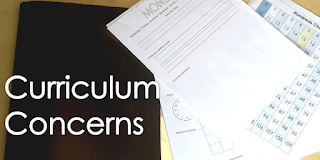Curriculum Concerns
"Study to shew thyself approved unto God, a workman that needeth not to be ashamed, rightly dividing the word of truth." 2 Timothy 2:15
The first place most homeschoolers start after they have decided to homeschool is choosing a curriculum. As you can tell by my name, I have some experience with curriculum development and now I hope to pass a little of my experience on to you. There are three types of curriculum available to homeschooling parents. The first, I'll call 'easy, cheap and boring', the next, 'easy, engaging and expensive', and finally, 'a lot of work, but cheap and engaging'. Let me give you the rundown on each.
The first, 'easy, cheap and boring', in my opinion is the way most homeschoolers go. They buy something like 'The Complete Canadian Curriculum' for less than $20 on Amazon, (not an affiliated, or endorsed link) and get their kid to go through the pages for an hour or two every morning and call it a day. This is an inexpensive way to get some ideas of what to teach, as well as some exercises in math and language for your child to do, but let me tell you it isn't any fun. In my opinion, if you took the same energy that it will take to get your child to do the work and put it into finding some interesting hands-on or project-based activities, your child will learn much more and both of you will be happier.
To sum it up, the pros of 'easy, cheap and boring' are that you can cover most of what they would learn in school at an affordable price, without to much of a headache on your part. The cons are that the work is quite monotonous and the learning is a bit superficial.
If you choose to go this route, take a good look at what your child is learning each day and plan at least, one engaging project or activity that they could work on to apply their learning. If you do that, this method will work quite well.
The second method is 'easy, engaging and expensive'. This method may sound like it has it all, if you are willing to fork over the money, but many times, it isn't as good as it seems. Here is an example of one I've found. As usual, I have no affiliation. Always know what your children are being taught and make sure it aligns with your family values. Also, make sure your presenting your child with a balanced curriculum that includes reading a variety of books or articles, different types of writing, the arts as well as physical activity. No matter how good, or expensive a curriculum is, every curriculum has its strengths and weaknesses. Another thing to look out for is that many of the new curriculum packages are available mostly online. Technology isn't bad, as a matter-of-fact I used it often with my kids, but, too much technology can leave your children susceptible to a variety of health problems. Again, balance is key.
If you choose this route, please check that the curriculum is comprehensive, as well as in line with your family values. Make sure to supplement any weaknesses in the curriculum and give your child enough exercise and outdoors time to counteract any extra screen time.
Finally, my favourite, the 'lots of work' method. I love planning fun activities and projects to teach my kids. That may be why I chose to be a teacher in the first place. I even like looking through the provincial curriculum documents to check the expectations at every grade level to make sure I have covered it all. However, I understand that doesn't sound like fun for everyone.
If you enjoy reading and are creative and organized enough to plan out ever activity for everyday of the school year, this method can be most effective. It is the only curriculum specifically designed for your family. I'll put links at the bottom to the curriculum documents for each province, so you can easily find what you need. They are free and it is exactly the same documents teachers in school would be using to teach your child.
If you choose this route, do a lot of planning in the summer, or whenever you have a break from school. Also, do not reinvent the wheel. Look online to get ideas of how other people have taught what you want to teach and don't be afraid to take a professional development day every now and again to give yourself time to get your best plans in order. There are lots of websites with online games, and lesson plans for free as well. Maybe you'll find exactly what you need.
As in life, nothing is perfect. Each of these methods have their pros and cons. Each have their redeemable qualities and ways to mitigate their issues. Carefully consider which method works best for your family and don't be afraid to combine methods or change part way through if something isn't working for you. Leave any questions or comments below.
And as always,
Curriculum links as promised:
Alberta: Elementary; Junior High; High School
B.C.: K-12
Manitoba: K-12
New Brunswick: K-12
Newfoundland: K-12
NWT: K-10, 20, 30
Nunavut: K-12
Ontario: Elementary; High School
PEI:K-12
Quebec: Elementary; Secondary
Saskatchewan: K-10, 20, 30
Yukon: Follows the B.C. Curriculum





Comments
Post a Comment